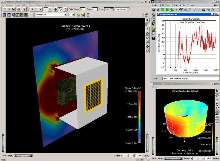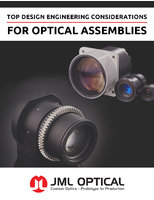Simulation Software facilitates EMC design.
Share:
Press Release Summary:

FLO/EMC v5 electromagnetic compatibility simulation software incorporates predefined and user-created parts libraries as well as automatic multigridding. It automatically combines small computational cells and lets users set up simulation that produces same type of data as anechoic chamber turntable measurement for emissions. Software uses Transmission Line Matrix (TLM) method for solving Maxwell's equations and offers option to discretize imported solid models.
Original Press Release:
FLO/EMC Version 5 Offers Unparalleled Ease-of-Use for EMC Design
(June 28, 2004) -- Flomerics has introduced Version 5 of its FLO/EMC electromagnetic compatibility (EMC) simulation software with major improvements including pre-defined and user-created parts libraries, automatic multigridding, and a number of EMC-specific usability features. The parts libraries substantially reduce modeling time by allowing users to import a wide range of popular components provided by vendors into their models. The new version also automatically combines small computational cells to increase the density of the mesh in areas with high field gradients and reduce it in areas with low gradients, thus optimizing the tradeoff between analysis accuracy and speed. Among the many usability features in the new version is the ability to automatically set up a simulation that produces the same type of data that would be obtained from an anechoic chamber turn-table measurement for emissions.
Flomerics will be working with components vendors to create SmartParts, i.e. ready-to-run models of popular enclosures, shields, absorbing materials and excitation sources. SmartParts are detailed behavioral models which are "aware" of the environment in which they are placed, and characterize the response of that part in a computationally efficient manner. Users can now simply drag and drop these components into their FLO/EMC models, saving a great deal of model-building time and increasing EMC modeling accuracy. For example, users can perform a detailed analysis of a printed circuit board and then save it as a SmartPart, providing a substantial reduction in computational time on subsequent enclosure-level analyses containing the same board.
The new version substantially improves the multigridding (i.e., cell combining) capabilities of FLO/EMC by adaptively populating the mesh based on geometric characteristics. For example, the software will apply a coarse mesh in open regions while placing a fine mesh in areas with a high field gradient, such as small holes. Another gridding improvement is the ability to represent the ground plane in a test chamber or external environment without the need to mesh the area between the system and the ground plane. The new version automatically computes the proper size of the bounding box around the structure used to establish grid boundaries.
FLO/EMC Version 5 also improves the handling of complex geometries by providing an option to discretize imported solid models using a grid that reproduces the model's shape to a high level of accuracy, while maintaining numerical efficiency and avoiding any issues relating to the quality and accuracy of the imported CAD data. In order to address an increasing interest in transient analysis, a new feature has been introduced that allows for the import of a comma-delimited ASCII file defining any desired voltage versus time waveform that can then be saved as a library item and used in subsequent simulations as the excitation source.
FLO/EMC Version 5 provides an advanced analysis environment for simulating electromagnetic interactions in and around electronic equipment for the purpose of generating quick solutions to tough design problems. FLO/EMC makes it possible to identify EMC design issues early in the design cycle, well before physical prototypes are built. FLO/EMC differs from general-purpose electromagnetic simulation software in that it uses the Transmission Line Matrix (TLM) method for solving Maxwell's equations, which provides major advantages when performing EMC simulations. The TLM method solves for all frequencies of interest in a single calculation and therefore captures the full broadband response of the system in one simulation cycle. This is particularly advantageous for EMC analysis since potential resonances and emissions vary over a wide frequency spectrum. In addition, the TLM method creates a matrix of equivalent transmission lines and solves for voltage and current on these lines directly. This uses less memory and CPU time than solving for E and H fields on a conventional computational grid.
For more information, visit Flomerics' Web site at www.flomerics.com




